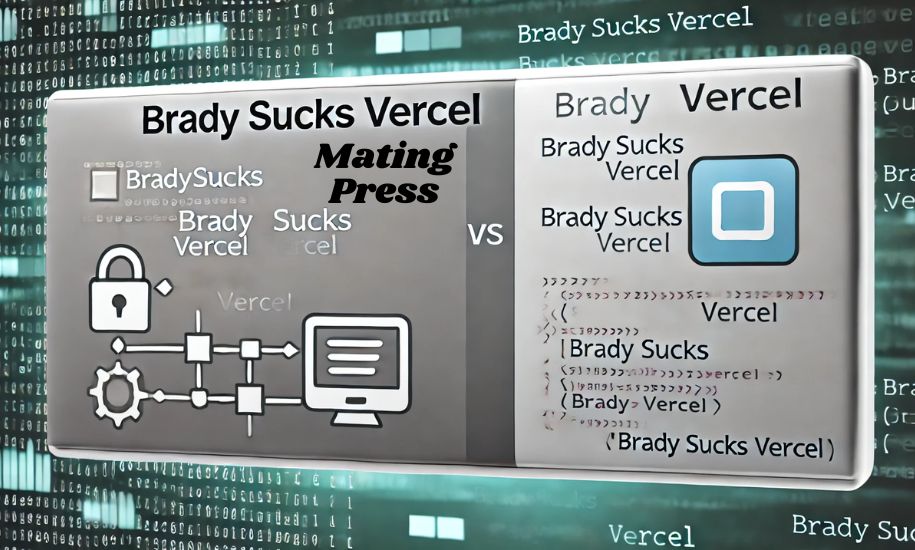Introduction
The phrase “Brady Sucks Vercel” has been echoing across tech forums and developer communities. It’s not a typical tech buzzword, but rather a humorous and slightly sarcastic jab at both a legendary football player and a cloud platform—Vercel. Though Tom Brady has nothing to do with this web development tool, the phrase has become symbolic of developers’ growing frustrations with Vercel’s performance, support, and reliability.
In this article, we’ll break down what “Brady Sucks Vercel” actually means, explore why some developers are turning away from the platform, and offer better alternatives. Whether you’re a beginner or an experienced developer, this comprehensive guide will help you decide if Vercel is the right tool for your web projects.
Understanding Vercel
What is Vercel?
Vercel is a cloud platform primarily used for frontend deployments. It supports frameworks like Next.js, React, Vue, and others. Known for its simplicity and developer-first approach, Vercel aims to help teams deploy fast, modern web applications globally with zero configuration.
Features Overview
| Feature | Description |
| Serverless Functions | Enables dynamic logic without managing servers |
| Edge Network | Delivers assets via a fast global CDN |
| Git Integration | Automatically deploys code from Git repositories |
| Preview Deployments | Creates URLs for every code push for easy testing |
| Analytics | Offers real-time performance monitoring |
Despite these features, many developers now associate the term “Brady Sucks Vercel” with frustration due to inconsistent performance and rising costs.
The Origin of “Brady Sucks Vercel”
So, where did this phrase come from? It started as an inside joke in a niche development community, merging sports banter with tech critique. “Brady Sucks” is a longstanding meme among football fans, especially those who aren’t fond of the former NFL quarterback. Add “Vercel” to the mix, and you get a catchy, meme-driven way for developers to vent about the shortcomings of a once-beloved hosting service.
The phrase gained traction on social media and was eventually turned into a parody site hosted—ironically—on Vercel itself. This tongue-in-cheek criticism turned serious as more users started agreeing with the sentiments being shared.
Common Criticisms of Vercel
1. Performance Issues
Developers complain about erratic build times, delayed deployments, and cold start delays in serverless functions. This becomes a dealbreaker for production-level applications that rely on speed and reliability.
2. Poor Customer Support
Unless you’re on an enterprise plan, don’t expect rapid responses. Users on free and lower-tier plans often wait days for solutions to critical issues.
3. Complexity Under the Hood
While marketed as “zero-config,” Vercel quickly becomes complex when projects grow. Debugging build failures and dealing with framework-specific quirks can take up valuable development time.
4. Expensive for Scaling
Costs rise significantly when your project starts to scale. Serverless invocations, edge functions, and bandwidth usage can quickly exceed your budget.
Technical Analysis
Vercel’s Architecture
Vercel uses a serverless and CDN-based architecture. While this is great for speed and low latency in theory, in practice, it suffers when handling dynamic content or when serverless functions cold start.
CDN and Edge Functions
Vercel’s global CDN is a highlight, but it’s not bulletproof. Developers in regions outside of North America sometimes experience inconsistent response times.
Build Pipeline
Another issue flagged under “Brady Sucks Vercel” is their opaque build system. Sometimes deployments fail without clear error messages, forcing developers to play detective.
Comparing Vercel with Alternatives
Netlify
Netlify offers similar features to Vercel, including Git integration, serverless functions, and preview URLs. It edges out Vercel with a more user-friendly dashboard and more generous free-tier offerings.
AWS Amplify
Amplify is a powerful alternative for applications that require full backend services. It integrates well with other AWS services, making it highly scalable and customizable.
Firebase Hosting
Firebase excels with real-time data and authentication out of the box. Its hosting is simple and effective for static sites and SPAs, although it lacks some advanced deployment features.
| Platform | Pros | Cons |
| Vercel | Fast CDN, Git sync | Poor support, scaling costs |
| Netlify | Easy UI, great free tier | Limited backend capabilities |
| AWS Amplify | Full backend integration | Steep learning curve |
| Firebase | Real-time DB, simple hosting | Not ideal for SSR apps |
Community and Ecosystem
Vercel has a strong open-source presence, particularly through its backing of Next.js. However, the “Brady Sucks Vercel” sentiment reveals a gap between corporate marketing and user experience. Community forums are active, but they’re often filled with unresolved issues or feedback that goes unacknowledged.
Developers want not just a tool—but a partner in their workflow. And Vercel is increasingly failing to deliver on that front.
SEO & User Experience Impact
SEO Considerations
Vercel supports both static site generation (SSG) and server-side rendering (SSR), both of which are good for SEO. However, slow response times from edge functions can impact your Core Web Vitals, which affects search engine rankings.
User Experience
For end users, inconsistent loading times and broken builds directly impact usability. It’s crucial to optimize pages, prefetch data, and reduce reliance on cold-start-heavy endpoints.
Security and Compliance
Vercel complies with industry standards like GDPR and ISO certifications. However, developers have raised concerns about the transparency of their data handling, particularly on the free tier. For enterprise clients, Vercel offers better control, but this comes at a steep price.
Case Studies
Success Story
A small startup used Vercel to launch their MVP in days, thanks to its quick setup and seamless GitHub integration.
Failure to Scale
A growing SaaS company had to migrate off Vercel after monthly bills soared and customer support failed to resolve uptime issues. Their site suffered downtime during peak hours, leading to revenue loss.
Best Practices & Recommendations
- Use Vercel for MVPs and smaller projects.
- For larger or enterprise-level apps, consider alternatives like AWS or Netlify.
- Regularly monitor usage and billing to avoid cost overruns.
- Implement fallback mechanisms to handle cold starts.
- Keep functions lean and cache intelligently.
Additional FAQs
1. Is Vercel open-source?
No, Vercel is a proprietary platform. However, it maintains several open-source projects like Next.js.
2. Can I self-host apps built for Vercel?
Yes, apps built using frameworks like Next.js can be self-hosted using Node.js servers or Docker.
3. Does Vercel support backend services?
Vercel primarily focuses on frontend deployment. While it offers serverless functions, it doesn’t replace a full backend.
4. How do I migrate from Vercel to another platform?
You’ll need to export your project, update environment variables, and configure hosting with a new provider like Netlify or Amplify.
5. What’s the best use case for Vercel today?
Vercel is ideal for static sites, personal portfolios, blogs, and MVPs where ease of use outweighs customization.
Conclusion
The phrase “Brady Sucks Vercel” may have started as a joke, but it has come to reflect a very real frustration within the development community. Vercel is a powerful platform—but it’s not without its flaws. For small-scale apps, it offers great value. But for teams seeking scalability, reliability, and support, alternatives may serve better in the long run.
Use this guide to make an informed decision about whether to stick with Vercel or look elsewhere for hosting your frontend applications.
Luna Base: Essential Support for a Lasting Manicure
Adrianna Apostolec: The Ultimate Comprehensive Guide





